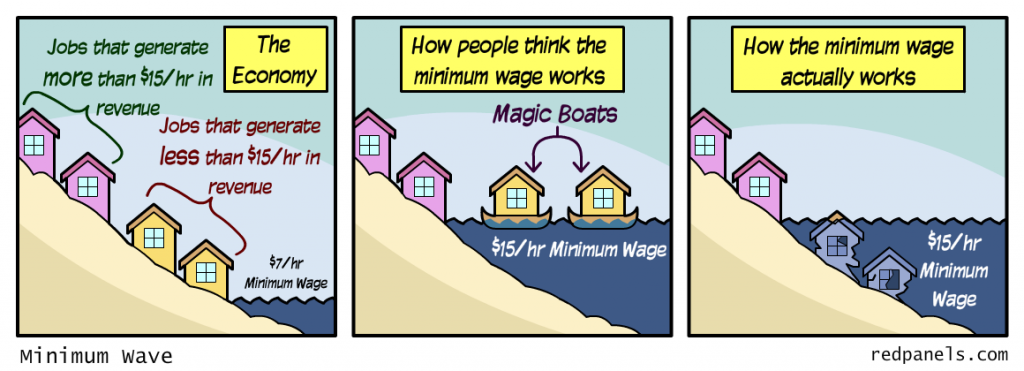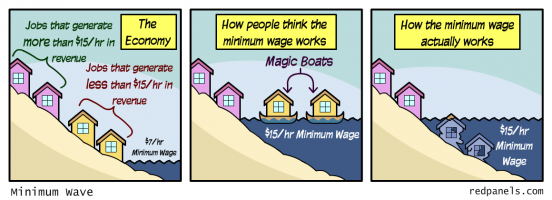
Eighteen states impose minimum wages higher than the federal minimum of $7.25 an hour. Among the states, California’s $12 an hour minimum is currently the highest (the minimum wage in the District of Columbia is $13.25). States are free to set whatever minimum wage they think is appropriate. This latitude notwithstanding, the American minimum wage debate takes place on the national stage for the most part.
If voters believe that raising the minimum wage helps workers, then politicians have an incentive to agitate in favor of increasing it. And we are now hip-deep into election season, which means that we should expect this issue to come up repeatedly as we ramp up to 2020. But people acquainted with the dismal science know that no amount of legislation can change the fact that the actual minimum wage is zero, which is what workers receive when the mandated wage rate prices them out of the market.
The Effect on Employment
As sure as the sun will rise in the east, when the price of any product goes up, people buy less of it. Minimum wage increases cause the price of labor to go up, and when that happens, people, in this case employers, hire less labor. The common misconception is that minimum wage legislation only affects how much employers pay, but it also affects whom they employ. The sad irony is that the beneficial wage effects of a minimum wage hike are largely felt by better skilled, better experienced, better-educated workers, while the detrimental employment effects are largely felt by less advantaged workers.
Requiring businesses to pay a higher wage forces employers to jettison their least valuable workers in order to afford the more valuable ones. Why? Because a higher minimum wage doesn’t make workers more productive; it simply makes them more expensive. Fifteen is just an arbitrary number politicians picked out of the air while looking for something appealing and alliterative.
How do we know? Because if a higher wage increased worker productivity beyond the cost of the increase, employers would be raising wages voluntarily.
In the end, raising the minimum wage transfers income from less valuable workers who become unemployed to more valuable workers who retain their jobs.
At the least, this makes the minimum wage a problematic tool for helping workers. Yet, there is a more fundamental issue at work. If raising the minimum wage is a good idea, why stop at $15 an hour? Wouldn’t $16 an hour be better still? Or $20? There is no magical property to a $15 minimum wage. Fifteen is just an arbitrary number politicians picked out of the air while looking for something appealing and alliterative.
The #FightFor15
Thus the #fightfor15 was born. Proponents admit that, beyond some point, raising the minimum wage will cause unemployment. But that’s a bait and switch. The laws of economics don’t suddenly kick in when prices rise high enough. Raising the minimum wage either causes unemployment at all wage rates, or it doesn’t cause unemployment at any of them.
The reality is that small increases in the minimum wage disemploy only the most marginalized workers—those with little to no education, no work experience, and no real job skills. Larger increases disemploy those with basic educations and some experience and skills. Large enough increases disemploy all workers.


Now remember, workers are also voters. So, what matters to politicians is whether the number of disemployed workers is large compared to the number of workers who will be earning more money in the event of an increase. It is a brutal calculus that causes real misery. But just as politicians gain votes by promising to tax the minority of rich people to give “free” things to everyone else, they also can gain votes by promising to take jobs from the minority of less-abled workers to give raises to the larger number of more abled workers. They will just never couch things in those terms. The political trick is to avoid raising the minimum wage so much that the number of disemployed workers becomes large enough to make trouble at the voting booth. That’s why you don’t hear politicians calling for a $100 minimum wage—yet.
It Won’t Stop at $15
The Fight for $15 became part of the Democratic party platform in 2016, and it has been on the front burner ever since. But everyone should be keenly aware that if Democrats are able to push the minimum wage to $15 an hour nationally, the urge to move it higher will be felt immediately.
One needn’t look too far for evidence of this. The House of Representatives just voted to increase the minimum wage to $15 by 2025. The 231-199 vote was, predictably, cast on party lines (three Republicans voted for it, six Democrats against). But everyone involved knows this bill has as much chance of passing into law as would heroin legalization. This vote was purely for show. Neither the Senate nor the president has any interest in passing anything like this legislation. And yet, the ink was barely dry on the page when the first call for a $20 an hour minimum wage was made.
Those who would legislate wages would like us to believe that wages are merely arbitrary details that can be dictated the way speed limits are.
It came, not surprisingly, from one of the so-called “Squad,” four of the most progressive leftists in the House. And while Alexandra Ocasio-Cortez gets most of the attention, this time it was Representative Rashida Tlaib of Michigan out in front. “When we started (the fight for an increased minimum wage), it should have been $15,” she said. “Now I think…it should be $20 an hour.”
She will one day lead the charge for a $25 an hour minimum wage. And on that day we will ask, in all earnestness, why not $26? Then, as now, politicians will not provide a good answer because the truth is too uncomfortable for them to admit publicly. Those who would legislate wages would like us to believe that wages are merely arbitrary details that can be dictated the way speed limits are. But every now and again, someone who has made a lifetime of this sort of prescriptive meddling comes up against his own handiwork, and that encounter is often as instructive as it is amusing.
Bernie Sanders As an Employer
Enter Bernie Sanders, who has raised a nearly nonstop fuss for the #FightFor15 over the last few years. In a joint announcement with #FightFor15 on Labor Day, Sanders was perfectly clear. “In the current political climate,” he said, “there are only two ways for workers to win higher pay. Number one, we’ve got to increase the minimum wage.” The data disagree. Currently, between 97 and 99 percent of workers (depending on whether one includes tipped workers) earn more than the minimum wage. So, for at least 97 percent of the American workers, there is some force other than the minimum wage driving up wages.
Sanders continues, “And second of all, we have got to build strong trade unions. But in Washington and across the country, many politicians are doing everything they can to keep wages low.” Given this almost myopic focus on the minimum wage, along with union membership, as the only way to ensure that workers earn a living wage, it is surprising that Sanders himself pays his campaign workers less than $15 an hour.
To be fair, Senator Sanders’ campaign workers are not hourly workers; they receive a fixed salary of around $36,000 a year. For a standard 40-hour work week, that’s the equivalent of more than $17 an hour. But, as is common for campaign workers and for salaried employees more generally, these workers almost always work more than 40 hours a week. For a campaign worker who works 50 or 60 hours a week, $36,000 is the equivalent of between $11 and $13 an hour. In response to charges of wage hypocrisy, Sen. Sanders announced that his campaign will limit the number of hours his workers will be allowed to work each week.Like employers everywhere, Sanders is making the best he can of restrictions placed on him on the one hand and the laws of economics on the other.
In that, he is behaving exactly as economic theory predicts: though in hours instead of bodies, he is nonetheless reducing the quantity of labor he hires.
It is easy to give Sanders the benefit of the doubt on this, and we absolutely should. He clearly wants workers to earn a living wage. But wishes don’t alter reality. Sanders is, perhaps for the first time in his life, bumping up against the economic reality that every employer faces. When the government requires that an employer pay a higher wage, one of three things must happen: the employer’s customers must pay higher prices; the employer’s investors must receive lower returns; or workers’ hours must be cut. Because political campaigns run on donations, there are no prices to raise and no investors to bleed. That leaves only the workers. To pay his campaign workers $15 an hour, Sanders has to cut their hours. This solution won’t put one extra dollar into his workers’ pockets. It will simply prevent them from working. It will raise his costs, though, because the work that needs to be done will still require the same number of man-hours.
Bernie Sanders now has to make the same hard choices that he and his like-minded colleagues have forced business owners to make for a very long time. While the right-wing chattering class had a field day calling him a hypocrite, Sanders is no more hypocritical than business owners are greedy. Like employers everywhere, he is making the best he can of restrictions placed on him by the whims of the ruling class on the one hand and the laws of economics on the other.
Abolish the Minimum Wage
While it is not palatable from the perspective of people running for political office, the answer to this problem is as simple as it is clear. We should not raise the minimum wage. We should abolish it altogether. The common response to this is that employers will immediately lower wages across the board, but to make that assertion one must ignore the fact that 97 to 99 percent of the American workforce already earns above the minimum wage.
To truly help workers requires that politicians first understand why wages are what they are. One can’t legislate that a worker earn a living wage any more than one can legislate that a farmer grow enough crops to feed his family.
When Sanders says that “there are only two ways for workers to win higher pay,” and then points to the minimum wage and labor unions, he suggests that he has no idea what determines wages. What determines a worker’s wage is the extent to which consumers want more of the things that the worker is capable of producing. One can’t legislate that a worker earn a living wage any more than one can legislate that a farmer grow enough crops to feed his family—and for the same reasons.
The way to increase wages is to increase the value of workers’ labor. And that happens through education, skills training, and work experience. Raising the minimum wage doesn’t provide for either of the first two, and it makes it harder to obtain the third. What the minimum wage does do, however, is allow politicians to buy votes from more abled workers by disemploying the less abled.
Portions of this article first appeared in the Philadelphia Inquirer.

Antony Davies
Dr. Antony Davies is the Milton Friedman Distinguished Fellow at FEE, associate professor of economics at Duquesne University, and co-host of the podcast, Words & Numbers.
This article was originally published on FEE.org. Read the original article.
